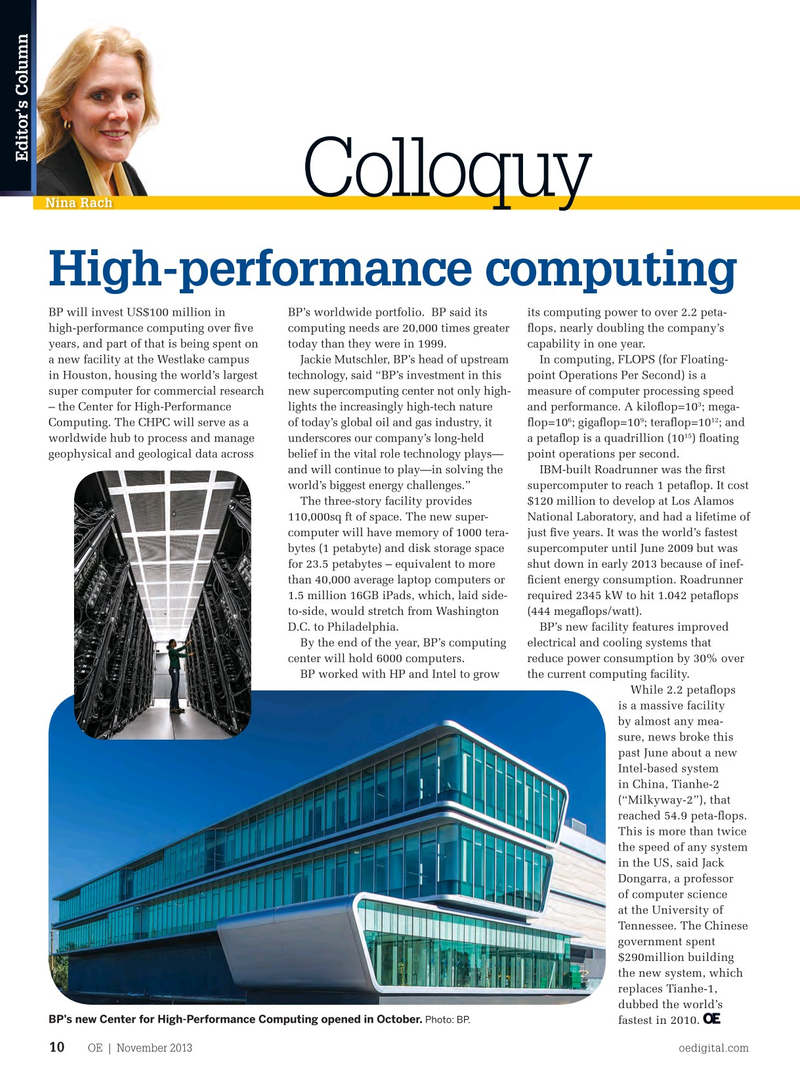
Page 8: of Offshore Engineer Magazine (Nov/Dec 2013)
Read this page in Pdf, Flash or Html5 edition of Nov/Dec 2013 Offshore Engineer Magazine
Editor’s Column
Colloquy
Nina Rach
High-performance computing
BP will invest US$100 million in BP’s worldwide portfolio. BP said its its computing power to over 2.2 peta- high-performance computing over fve computing needs are 20,000 times greater fops, nearly doubling the company’s years, and part of that is being spent on today than they were in 1999. capability in one year. a new facility at the Westlake campus Jackie Mutschler, BP’s head of upstream In computing, FLOPS (for Floating- in Houston, housing the world’s largest technology, said “BP’s investment in this point Operations Per Second) is a super computer for commercial research new supercomputing center not only high- measure of computer processing speed 3 – the Center for High-Performance lights the increasingly high-tech nature and performance. A kilofop=10 ; mega- 6 9 12
Computing. The CHPC will serve as a of today’s global oil and gas industry, it fop=10 ; gigafop=10 ; terafop=10 ; and 15 worldwide hub to process and manage underscores our company’s long-held a petafop is a quadrillion (10 ) foating geophysical and geological data across belief in the vital role technology plays— point operations per second.
and will continue to play—in solving the IBM-built Roadrunner was the frst world’s biggest energy challenges.” supercomputer to reach 1 petafop. It cost
The three-story facility provides $120 million to develop at Los Alamos 110,000sq ft of space. The new super- National Laboratory, and had a lifetime of computer will have memory of 1000 tera- just fve years. It was the world’s fastest bytes (1 petabyte) and disk storage space supercomputer until June 2009 but was for 23.5 petabytes – equivalent to more shut down in early 2013 because of inef- than 40,000 average laptop computers or fcient energy consumption. Roadrunner 1.5 million 16GB iPads, which, laid side- required 2345 kW to hit 1.042 petafops to-side, would stretch from Washington (444 megafops/watt).
D.C. to Philadelphia. BP’s new facility features improved
By the end of the year, BP’s computing electrical and cooling systems that center will hold 6000 computers. reduce power consumption by 30% over
BP worked with HP and Intel to grow the current computing facility.
While 2.2 petafops is a massive facility by almost any mea- sure, news broke this past June about a new
Intel-based system in China, Tianhe-2 (“Milkyway-2”), that reached 54.9 peta-fops.
This is more than twice the speed of any system in the US, said Jack
Dongarra, a professor of computer science at the University of
Tennessee. The Chinese government spent $290million building the new system, which replaces Tianhe-1, dubbed the world’s
BP’s new Center for High-Performance Computing opened in October. Photo: BP.
fastest in 2010.
OE | November 2013 oedigital.com 10 000_OE1113_Colloquy.indd 10 10/28/13 3:25 AM

 7
7

 9
9